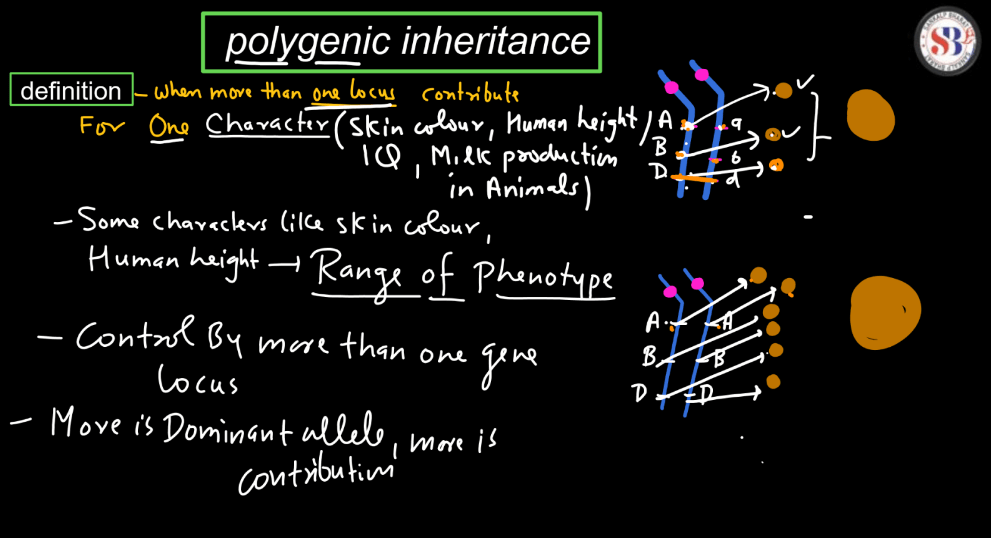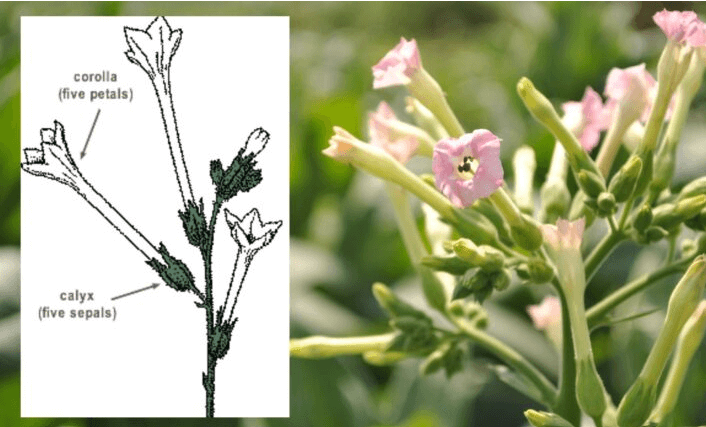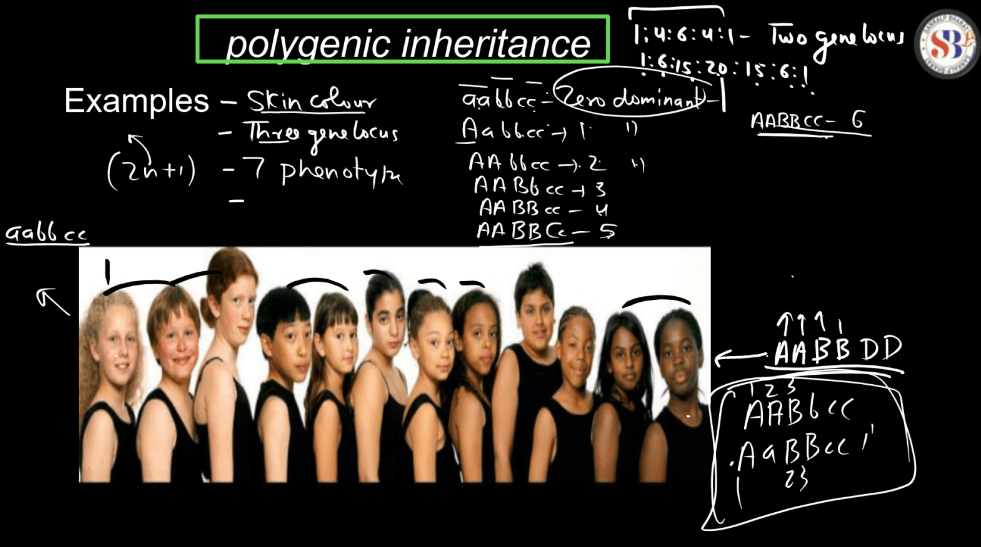Table of Contents
What is Polygenic Inheritance?
Polygenic inheritance is a way traits are passed down from parents to offspring involving multiple genes, unlike simple traits controlled by one gene. Unlike simple traits controlled by one gene, polygenic traits result from the combined influence of many genes. Each gene contributes a small effect to the overall trait, and the more genes involved, the more continuous and varied the trait appears. Think of it like a recipe with several ingredients, and together they determine the final outcome. For example, human height is a polygenic trait influenced by various genes. Each gene adds a little to the height, and the combination of these contributions determines how tall or short a person becomes. Environmental factors also play a role, making polygenic traits complex and influenced by both genetic and environmental factors.

Polygenic Inheritance in Plants
Polygenic inheritance in plants refers to the inheritance in plants refer to the inheritance of traits controlled by multiple genes, each contributing in varying degrees to the phenotype. Unlike simple Mendelian traits determined by a single gene, polygenic traits result from the combined influence of multiple gene pairs. These genes interact with each other and environmental factors, leading to a wide range of trait variations within a population.

An example is play height, where numerous genes contribute to the final height. The more genes involved, the more continuous and diverse the trait variations. Polygenic inheritance often leads to a bell-shaped distribution of traits, creating a spectrum rather than distinct categories. Understanding polygenic inheritance is crucial in plant breeding, as it helps predict and manipulate trait expression in crops for improved yield and resilience.
Examples of Polygenic Inheritance
Polygenic inheritance refers to the influence of multiple genes on a single trait. Some examples of polygenic inheritance are discussed below. These examples showcase the polygenic nature of inheritance, where the combined effects of several genes contribute to the observed traits or susceptibility to certain conditions.
- Human Eye Color: Eye color is influenced by several genes, including those affecting the production and distribution of melanin. The combination of these genes determines the final eye color.
- Skin Pigmentation: The color of skin is determined by multiple genes involved in melanin production, distribution, and regulation. This contributes to the wide range of skin tones observed in human populations.
- Type 2 Diabetes Risk: The risk of developing type 2 diabetes is influenced by the combined effects of multiple genes related to insulin regulation, Glucose metabolism, and other factors.

- Hypertension (High Blood Pressure): Genetic factors play a role in determining an individual’s susceptibility to hypertension, with multiple genes contributing to blood pressure regulation.
- Schizophrenia Risk: Schizophrenia has a complex genetic basis, involving the interaction of various genes associated with neurotransmitter function, Brain structure, and other factors.
- Cleft Lip and Palate: The occurrence of cleft lip and palate is influenced by the interplay of multiple genes involved in facial development during embryogenesis.
Characteristics of Polygenic Inheritance
Polygenic inheritance involves multiple genes contributing to the expression of a trait. Below we have discussed a few points that will highlight the characteristics of polygenic inheritance. Understanding polygenic inheritance is crucial for unraveling the genetic basis of complex traits and diseases.
- Multiple Genes: Polygenic traits are influenced by more than one gene, often located on different chromosomes.
- Continuous Variation: Phenotypes exhibit a wide range of continuous variation rather than distinct categories, creating a spectrum of trait expression.
- Additive Effects: Each gene contributes incrementally to the phenotype, and the effects of these genes are additive. The more “contributing” alleles present, the more pronounced the trait.
- Environment Interaction: Environmental factors can influence the expression of polygenic traits, adding another layer of complexity to their inheritance.
- Normal Distribution: The distribution of phenotypes often follows a bell-shaped curve, reflecting the cumulative effects of multiple genes.
- Complex Traits: Polygenic traits are often associated with complex traits such as height, skin color, or intelligence, where many genetic and environmental factors play a role.
Some more interesting Facts on Polygenic Inheritance
Polygenic Inheritance involves the combined effect of multiple genes on a single trait. Some of the interesting facts on polygenic inheritance are discussed below. In summary, polygenic inheritance underscores the intricate interplay of multiple genes and environmental factors in shaping the characteristics of organisms.
- Multiple Genes Influence Traits: Polygenic traits, such as height or skin color, result from the interaction of several genes, each contributing to the final phenotype.
- Continuous Variation: Polygenic traits often show a wide range of continuous variation rather than distinct categories. This leads to a spectrum of phenotypes in a population.
- Environment Plays a Role: Environmental factors can also influence the expression of polygenic traits, adding another layer of complexity to their inheritance.
- Bell Curve Distribution: Polygenic traits often follow a bell curve distribution in a population, with most individuals clustered around the average and fewer at the extremes.
- Human Examples: Human traits like intelligence, height, and susceptibility to certain diseases are influenced by polygenic inheritance, reflecting the combined effects of many genes.
- Quantitative Traits: Polygenic traits are often referred to as quantitative traits because they can be measured on a continuous scale.
- Recombination Variation: The random assortment and recombination of genes during meiosis contribute to the diversity of polygenic traits within a population.
- Selective Pressures: Polygenic inheritance can provide a basis for natural selection, as the combination of genes that confer an advantage in a particular environment may become more prevalent over time.
- Genome-Wide Association Studies (GWAS): Scientists use GWAS to identify specific genes associated with polygenic traits, helping to understand the genetic basis of complex characteristics.
- Genetic Counseling Implications: Understanding polygenic inheritance is crucial in genetic counseling, especially for predicting the likelihood of certain traits or diseases in offspring.








 50 Vegetables Name for Kids in English a...
50 Vegetables Name for Kids in English a...
 Body Parts Name, All 50 Body Parts Name ...
Body Parts Name, All 50 Body Parts Name ...
 Flowers Names in English and Hindi, List...
Flowers Names in English and Hindi, List...









